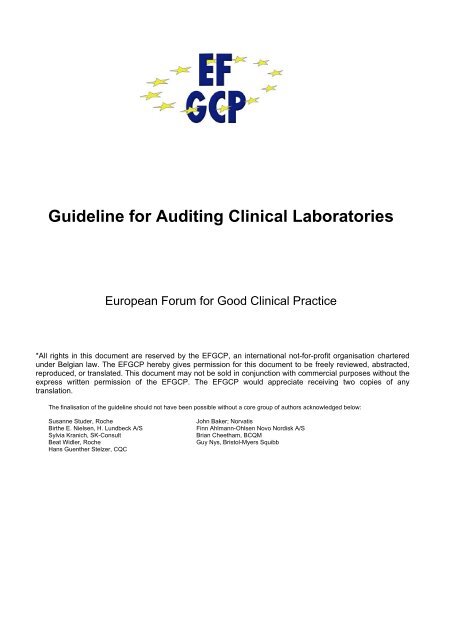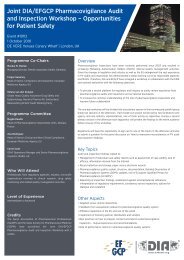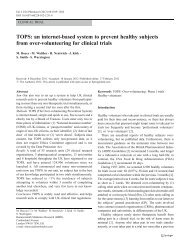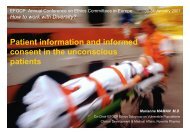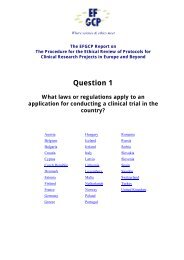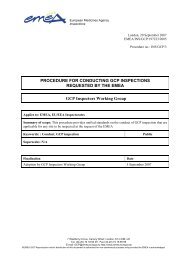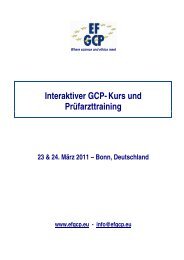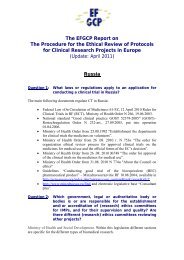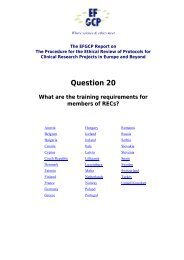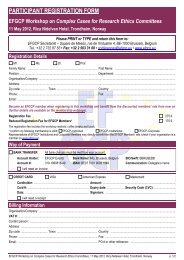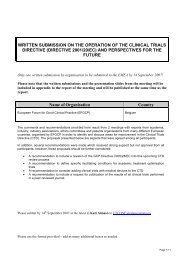EFGCP Guideline for Auditing Clinical Laboratories - European ...
EFGCP Guideline for Auditing Clinical Laboratories - European ...
EFGCP Guideline for Auditing Clinical Laboratories - European ...
Create successful ePaper yourself
Turn your PDF publications into a flip-book with our unique Google optimized e-Paper software.
<strong>Guideline</strong> <strong>for</strong> <strong>Auditing</strong> <strong>Clinical</strong> <strong>Laboratories</strong><strong>European</strong> Forum <strong>for</strong> Good <strong>Clinical</strong> Practice*All rights in this document are reserved by the <strong>EFGCP</strong>, an international not-<strong>for</strong>-profit organisation charteredunder Belgian law. The <strong>EFGCP</strong> hereby gives permission <strong>for</strong> this document to be freely reviewed, abstracted,reproduced, or translated. This document may not be sold in conjunction with commercial purposes without theexpress written permission of the <strong>EFGCP</strong>. The <strong>EFGCP</strong> would appreciate receiving two copies of anytranslation.The finalisation of the guideline should not have been possible without a core group of authors acknowledged below:Susanne Studer, RocheBirthe E. Nielsen, H. Lundbeck A/SSylvia Kranich, SK-ConsultBeat Widler, RocheHans Guenther Stelzer, CQCJohn Baker; NorvatisFinn Ahlmann-Ohlsen Novo Nordisk A/SBrian Cheetham, BCQMGuy Nys, Bristol-Myers Squibb
<strong>Guideline</strong> <strong>for</strong> <strong>Auditing</strong> <strong>Clinical</strong> <strong>Laboratories</strong>1 IntroductionThe purpose of this <strong>Guideline</strong> is to contribute to a pharmaceutical industry standard <strong>for</strong> auditing <strong>Clinical</strong><strong>Laboratories</strong> to assess compliance with international GCP <strong>Guideline</strong>s and regulations and, whereapplicable, GLP and other laboratory and laboratory-related (e.g. IATA) regulations.This document should be used only <strong>for</strong> guidance; the auditor must remain flexible and include new areasin the scope and objectives of the audit, if identified during the auditing process. In considering the roleand responsibilities of auditors, this guideline is supported by the ENGAGE <strong>Guideline</strong>: Optional <strong>Guideline</strong><strong>for</strong> Good <strong>Clinical</strong> Practice Compliance and Quality Systems.2 ScopeThis document covers laboratories which process and analyse biological samples (safety and/or efficacyparameters) in clinical studies as well as those carrying out immunological assays and/or other specialassays such as drug assays used <strong>for</strong> pharmacokinetics and/or proof of compliance.The audit may take the <strong>for</strong>m of an evaluation prior to the signature of a contract between the laboratoryand sponsor and be<strong>for</strong>e the start of the study or an audit during the conduct of a clinical study.The audit will cover overall management of the facility; quality management systems; the handling,analysis and result reporting of samples processed; data management, computer systems, includingcompliance with 21 CFR Part 11, and archiving.3 Audit of <strong>Clinical</strong> <strong>Laboratories</strong> (GCP)3.1 Preparing a Laboratory AuditThe laboratory should be contacted a minimum of 3-4 weeks in advance to schedule the audit.The audit plan and the proposed agenda should be discussed with the audit team and the arrangementsconfirmed in writing. Requesting certain key documents in advance of the audit can help during auditpreparation. In<strong>for</strong>mation may also be available on the Internet, i.e. services provided, etc. Thefollowing should be considered if applicable:Copies of Accreditation and/or Certification documents.The prospectus of the laboratory and description of the services offered.The list of affiliations and/or contracts with third parties per<strong>for</strong>ming tasks on behalf of the laboratory tobe audited e.g. kit assembly, courier service, data management, service contractors <strong>for</strong> lab.equipment and computer system validation.Evidence of participation in external QC schemes other than Certification / Accreditation.Flow charts of the processing of samples and the handling of data.The list of SOPs, guidelines, work instructions and manuals.Organogram(s).The auditor should meet with the responsible clinical team members and/or purchasing department toobtain essential in<strong>for</strong>mation. The following should be considered if applicable:• Copies of the contract(s) and work order(s).• Definition of roles and responsibilities at the sponsor, investigational and laboratory sites.• Any subcontractors involved e.g. kit assembly, specific assays and analyses, courier services etc.• Long-term specimen storage, the archiving of electronic data and hard copy records.• Data management specifications – transfer of data (e.g. electronically, encryption, e-mail, ASCIIfile, Excel sheet, online in batch mode or real time).• Interfaces between laboratory, sponsor and other third party vendors involved in the process<strong>EFGCP</strong> - <strong>Clinical</strong> <strong>Laboratories</strong> - Final Version 1.0 Page 2 of 15 2005
<strong>Guideline</strong> <strong>for</strong> <strong>Auditing</strong> <strong>Clinical</strong> <strong>Laboratories</strong>• Previous sponsor experience with the laboratory should be evaluated e.g. by reviewing sample ofdata from completed studies or previous audit reports.• A review of the relevant project/study-specific sponsor documentation e.g. correspondence, datatransfer specifications.• Check if there have been any communication issues or other problems between sponsor andlaboratory and/or laboratory and other sub-contractors.Comment: when study-specific documentation is kept by a the clinical laboratory, the auditor shouldarrange a meeting with the responsible clinical team/project team.3.2 Conducting a Laboratory Audit; Review of documentation related to organisationThe audit will normally be initiated by an opening interview where the auditors will introduce themselvesand present the scope and objectives of the audit. Furthermore the auditors and the auditee(s) will agreeon the agenda.3.2.1 Laboratory Management – OrganisationThe aim of this meeting is to obtain an overall impression of the laboratory together with some basicin<strong>for</strong>mation concerning its financial status in order to identify any factors that could become critical <strong>for</strong> theability to fulfil the contract. In addition, the auditor must establish that the laboratory is a permanent andstable organisation with a proven track record and assess its capabilities on a local and/or global basis.The auditor should obtain in<strong>for</strong>mation concerning the following:• An organisational chart which identifies key personnel e.g. project/study/account managers,laboratory staff, data manager, IT staff, internal QA staff.• In<strong>for</strong>mation concerning funding, economic background (e.g. privately owned vs. public company),partners, sister organisations, recent or announced mergers and dependency relationships.• The number of permanent employees and the policy of subcontracting to outside consultantsand/or temporary and part-time employees.• The policy <strong>for</strong> the back-up of key personnel to ensure adequate supervision throughout the entirecontract / study period and any procedures <strong>for</strong> duties outside normal working hours.• The capacity and type of clinical sample analyses per<strong>for</strong>med per day and per year, and evidencethat the analysis work can be per<strong>for</strong>med promptly according to contract• The experience in any special tests that may be required.• The numbers and type of clinical studies (including the number of sponsors) handled by thelaboratory at any one time.• The procedures available <strong>for</strong> the activities to be per<strong>for</strong>med at the laboratory e.g. the handling ofthe results of routine laboratory tests and communicating the results to the sponsor.• Procedures / Policies must be available <strong>for</strong> all activities per<strong>for</strong>med by the laboratory including:• The procedures <strong>for</strong> handling abnormal test results including sample re-analysis and analysesper<strong>for</strong>med outside protocol time-window.• The determination and updating of reference values.• Courier and transportation agreements (IATA).• Sample retention / destruction.• The archiving of both paper and electronic data.• Physical security and fire protection systems• Validation of computer systems and compliance with 21 CFR Part 11.• If a sub-contracted laboratory is used, the auditor should determine which SOPs orstandards are to be used and whether the systems are standardised and agreed timelinesare adhered to.<strong>EFGCP</strong> - <strong>Clinical</strong> <strong>Laboratories</strong> - Final Version 1.0 Page 3 of 15 2005
<strong>Guideline</strong> <strong>for</strong> <strong>Auditing</strong> <strong>Clinical</strong> <strong>Laboratories</strong>3.2.2 Personnel – Roles, Responsibilities and Training• Procedures/Policies must be available <strong>for</strong> training personnel and <strong>for</strong> updating job descriptions;CVs and training records must also be available.Using the organisation chart the auditor should select a representative sample of key personnel andcheck the CVs, job descriptions and training records as follows:Job Descriptions: Verify that the documents are consistent with the organisation chart, and thatroles and responsibilities and reporting lines are clearly defined and that the documents areupdated signed and dated by the employee and management supervisor.• CV / Training records: Verify that relevant qualifications are documented which enableindividuals to fulfil tasks/obligations as stated in the job description. The auditor should checkthat the documents are updated and approved as necessary (signed and dated). Trainingincludes the handling of equipment and quality management as well as SOP-training. GXPand IATA courses might be relevant depending on the position of the employee and thetasks per<strong>for</strong>med. For other functions such as the archiving of clinical laboratory data,correspondence with sites, review and release of results to sites should be covered.Temporary employees are very often used by central laboratories and special care should betaken to verify the CVs and training records of such employees.In addition, the training program <strong>for</strong> new employees should be checked. e.g. laboratory staff, datamanagement, kit assembly.In the case of sub-contracted partners or consultants, the auditor should verify that contracts CVs,job descriptions and training records are available and that the terms and duration ofemployment are documented.3.3 Quality Management (QC / QA)The objective is to have an understanding of the Quality Management procedures at the laboratory andthe following in<strong>for</strong>mation and documentation should be obtained.:The Quality Policy and/or Quality Manual. The auditor should check it is current and has been authorisedby upper management.• Accreditation / Certification – determine to which international standard the laboratory works e.g. ISO9000, ISO/IEC 17025, EN 45001, CAP, CLIA, GLP, GCP (if the laboratory claims to work according toGLP section 4.0 of this article is particularly pertinent)• Computer System Validation - Verify that the Quality Management System covers computerizedsystems in compliance with 21 CFR Part 11.Quality Control - Verify that the laboratory participates in an external QC scheme ("inter-calibrationprograms"); how often control samples are received and analysed; and whether the schedule <strong>for</strong>eseenby the external body is respected. The documentation / results and check procedures <strong>for</strong> handling "outof specification" results should be checked. The procedure to include feedback to sponsor if thelaboratory has been proved to be "out of range" <strong>for</strong> a period should also be checked.The quality management of the outsourced work carried out by sub-contractors or other third parties usedby the central laboratory in order to provide contracted services. (Are audits of sub-contractedlaboratories <strong>for</strong> special analysis, couriers, etc. carried out?).<strong>EFGCP</strong> - <strong>Clinical</strong> <strong>Laboratories</strong> - Final Version 1.0 Page 4 of 15 2005
<strong>Guideline</strong> <strong>for</strong> <strong>Auditing</strong> <strong>Clinical</strong> <strong>Laboratories</strong>• The scope of any Inspections by regulating authority/accrediting authority. If any inspections havebeen per<strong>for</strong>med the auditor should review the reports and, if applicable, any preventive or correctiveactions. Verify that the corrective actions have been implemented. It should also be checked if theinspection is relevant in terms of timing, scope and outcome to the current contract.3.3.1 Quality AssuranceSpecial attention should be paid to the following issues:• Qualification of the QA personnel including the QA Manager (e.g. CVs, job descriptions andtraining records).• The independence of QA department, e.g. reporting lines of QA staff.• Overall policy of auditing including the scope and frequency of audits as defined in the audit planand evidence that the audits have been conducted.• Procedures <strong>for</strong> reporting observations/non-compliance issues to management and / or theSponsor.• Procedures <strong>for</strong> the follow up and resolution of observations regarding non-compliance issues.• The role of QA in the management and control of Standard Operating Procedures.• Audit of subcontractors3.4 Conducting a Laboratory Audit: Facilities and EquipmentIn order to have an overall impression of the facility the auditor should review:Ground / floor plans: a sketch map of the site; size of the testing facility.Policy <strong>for</strong> environmental control.List of significant equipment.List of available assays / analyses.A key task of any laboratory audit is an extensive tour of the facilities. This gives the audit team anoverview of all the facilities and allows them to follow in detail the procedures used to analyse andprocess a clinical sample i.e. the entire workflow. The following should be reviewed:The procedures <strong>for</strong> the preparation and dispatch of kits to clinical trial centres and the provision ofadditional materials to the investigator e.g. ‘Investigator Instruction Manual <strong>for</strong> Sample Handling andShipments’.The receipt, processing and storage areas with regard to the re-labelling of samples, safety proceduresused, temperature control of the premises and, where applicable, equipment, hygiene, and security.The overall impression of the laboratory e.g. cleanliness, no smoking and food policy, air-conditioning,safety provisions <strong>for</strong> staff (e.g. use of “white coats”, gloves, eye protection).The procedures in place <strong>for</strong> the management of laboratory waste and its disposal. Special attentionshould be paid to the disposal of hazardous waste such as radioactive or infectious materials.The procedures <strong>for</strong> the analysis of samples, the batch release and reporting of results to the investigatorsand sponsor (see also Section Data Handling’ below).The archiving facilities and retention procedures <strong>for</strong> biological specimens and <strong>for</strong> paper and electronicfiles.The security systems should be evaluated. This should include verifying that access to the facility iscontrolled, guests are identified, registered, and guided at all times during the audit, and asked to wear anidentification badge and protective clothing. Furthermore, it should be checked that access to specialisedareas is restricted and has additional security and access control provisions (e.g. areas that handleradioactive materials and the In<strong>for</strong>mation Technology department with the server facility).<strong>EFGCP</strong> - <strong>Clinical</strong> <strong>Laboratories</strong> - Final Version 1.0 Page 5 of 15 2005
<strong>Guideline</strong> <strong>for</strong> <strong>Auditing</strong> <strong>Clinical</strong> <strong>Laboratories</strong>3.4.1 Equipment and ReagentsDuring the audit at the bench site the auditor should ask staff to explain how critical tasks are executed,e.g. procedures <strong>for</strong> acceptance and testing of internally developed assay methods.For critical steps and/or equipment written instructions should be compared against actual work practicesduring per<strong>for</strong>mance of an analysis/task.The following should be covered:Back up systems; provisions in case of power failure; contingency plans <strong>for</strong> mechanical failure ofsystems or shutdowns of entire systems, departments, etc.• Back-up equipment and procedures <strong>for</strong> each machine in case of instrument failure (e.g.analysers, incubators, freezers, refrigerators, centrifuges, pipettes of various types – Eppendorf -,ELISA reader).Procedures and their implementation <strong>for</strong> monitoring calibration and standardization of equipment.Documentation of day-to-day per<strong>for</strong>mance and functioning documented in logbooks. The auditorshould look <strong>for</strong> evidence of calibration of pipettes, evidence <strong>for</strong> daily calibration of analysers,freezers.SOPs / procedures in the laboratory. The auditor should look <strong>for</strong> current versions at the bench andwhether these bear any hand-written changes.• Written procedures and documentation (logbooks) <strong>for</strong> service/maintenance of equipment.The following aspects should be reviewed:Maintenance contracts specifying timelines <strong>for</strong> providing service and fixing the problem.Procedures specifying responsibilities <strong>for</strong> maintenance as well as frequency, tracking andcontrolling of compliance with maintenance schemes.Documentation <strong>for</strong> the installation of equipment (Installation Qualifications) and further verifyingwhether maintenance contracts have been in place during the entire life-cycle of a givenpiece of equipment and whether contractual agreements have been adhered to.• Written procedures <strong>for</strong> the labelling and storage of materials and reagents. In addition, this shouldinclude the following aspects:• Materials stored in compliance with laboratory procedures and/or suppliers’ instructions.• Labels on reagents and aliquoted reagents/materials show source, identity, concentration,expiry and opening date, Lot number, storage conditions.• ‘Inventory Log’ <strong>for</strong> reagents and materials and responsibility (ies) <strong>for</strong> orderingreagents/materials and maintaining the ‘Inventory Log’.• Temperature monitoring of freezers and refrigerators• Manual or electronic temperature log 7 days/weekly• Alarm systems and documentation of the test of alarms (frequency of planned tests vs. executedtests) and the outcome of testing of alarm systems• Availability of and compliance with SOPs <strong>for</strong> handling and documenting "out of specification"periods• Inventories and QC check of storage3.5 Kit Preparation and Investigator SupportSampling kits generally include tubes, labels, pro-<strong>for</strong>ma invoices, airway bills and boxes <strong>for</strong> the dispatchof the sample tubes by the clinical sites to the central laboratory.If a Central Laboratory is responsible <strong>for</strong> the preparation and shipment of the sampling kits the auditorshould review the following items:• Were any steps pertaining to the kit preparation subcontracted?• Who is responsible <strong>for</strong> the preparation of training materials <strong>for</strong> instructing the site staff on thecorrect procedures <strong>for</strong> sample processing and dispatch and how the site staff and monitors are<strong>EFGCP</strong> - <strong>Clinical</strong> <strong>Laboratories</strong> - Final Version 1.0 Page 6 of 15 2005
<strong>Guideline</strong> <strong>for</strong> <strong>Auditing</strong> <strong>Clinical</strong> <strong>Laboratories</strong>trained, e.g. whether the laboratory requests to be involved in investigators’ and monitors’workshops or other contacts between sponsor/investigator.• The contents and management of instruction manuals <strong>for</strong> the drawing, handling, processing(centrifuging) and dispatch of samples. It should also be checked whether and how the Manual onSample Handling has addressed protocol requirements and interactions with courier services.• The types of kit available, the compliance of packaging materials and procedures with IATAregulations,• The procedures <strong>for</strong> managing clinical trial centres (e.g. keeping track of materials sent,inventories, re-stocking).• The procedures <strong>for</strong> the recall of faulty materials sent to sites. It must also be verified that thereare written procedures describing the recall process, and that these take into account the need tonotify the sponsor.• Systems <strong>for</strong> handling of complaints including follow up, documentation of sequence of events andarchiving of related correspondence. It must also be verified that the procedures are beingfollowed by reviewing a sample of dispatch records and “complaint notifications”, if available.• Procedures <strong>for</strong> review and approval of labels, kit contents etc.• Quality Control (QC) procedure <strong>for</strong> the kit preparation such as percentage of checked kits.• Review of kits, e.g. expiry dates (the earliest expiry date of any item included determines theexpiry of the whole kit).3.6 TransportationIf Couriers are used, the type and extent of sub-contracted activities should be evaluated as follows:Procedures of the courier <strong>for</strong>:being contacted by investigators.pick-up of samples.documenting receipt of samples.storing packages.documenting delivery of packages to the laboratory and biological safety precautions (courierprocedures and / or sponsor requirements)If any of the above steps are sub-contracted, the extent of arrangements and supervision by CourierCompany must be verified.Contingency arrangements with the courier in case of strikes, custom problems, transportation problems.Temperature monitoring during transport and the documentation thereof.Interactions between the laboratory and the courier company, e.g. monitoring of the courier’s per<strong>for</strong>manceand procedures to give feedback to the sponsor in case of unsatisfactory per<strong>for</strong>mance of the courier.3.7 Handling Samples<strong>EFGCP</strong> - <strong>Clinical</strong> <strong>Laboratories</strong> - Final Version 1.0 Page 7 of 15 2005
<strong>Guideline</strong> <strong>for</strong> <strong>Auditing</strong> <strong>Clinical</strong> <strong>Laboratories</strong>Obtain and review the flow chart, describing the overall progress of samples in order to identify the criticalprocesses such as:The identification of samples throughout the workflow.The splitting of samples <strong>for</strong> analysis and the identification of the aliquots during the process.QC procedures <strong>for</strong> sample processing.Calibration and validation of systems.3.7.1 Receipt and Processing of SamplesReceipt of samples is a critical step as they may be re-labelled and stored until the analysis is per<strong>for</strong>med.The following should be reviewed:The system <strong>for</strong> registering and, if applicable, labelling the samples and recording the date of sampling,receipt, analyses and date and time of reporting the results.Procedures <strong>for</strong> the confirmation to the investigator and/or the study monitor of the receipt of samples.Feedback to clinical trial site if the quality of samples and/or documentation is inadequate. Thisincludes documentation of the sequence of events, procedures <strong>for</strong> prevention of repeat errors andimmediate feedback to sites.The date of sampling and date of analyses should be compared to assess if the lag time is supportedby stability data <strong>for</strong> each of the analytes.Procedures <strong>for</strong> un-packing samples:• Personal safety protection procedures such as use of gloves, protecting glasses, etc.• Check of received packages, tubes and request <strong>for</strong>ms <strong>for</strong> physical integrity, completenessand adequacy of in<strong>for</strong>mation.• Procedures used <strong>for</strong> inspection of received goods and materials, manual vs. electronic.• Documentation of related QC procedures and <strong>for</strong> resolution/follow-up of errors/deviations.Laboratory opening hours; procedures <strong>for</strong> receipt of samples outside working hours, arrangements <strong>for</strong>sickness cover, vacation and public holidays.• Storage of samples until analysisProcedure <strong>for</strong> processing samples with missing essential data on the accompanying laboratoryrequisition sheet / label:The tracking, storage of samples, when these are kept back.The flagging and tracking of samples, when these are analysed with high priority.The process <strong>for</strong> obtaining missing in<strong>for</strong>mation from clinical trial centres and documentation of thisprocess.The procedure <strong>for</strong> handling missing or broken samples as well as additional and/or unscheduledsamples.3.8 Sample AnalysisThe capacity of the facility limits the throughput time of samples and should be assessed in view thenumber of samples received on a given day and over a given time period. This is especially important inthe case of “non-standard” analyses in which the duration of the process and the number of samples thatcan be processed daily are the rate limiting factors. The analytical run time <strong>for</strong> standard haematology andclinical chemistry measurements is generally not rate limiting.The following should be reviewed:• The validation status of the assays and related documentation with reference to the applied standards(e.g. ICH Q2A and ICH Q2B).<strong>EFGCP</strong> - <strong>Clinical</strong> <strong>Laboratories</strong> - Final Version 1.0 Page 8 of 15 2005
<strong>Guideline</strong> <strong>for</strong> <strong>Auditing</strong> <strong>Clinical</strong> <strong>Laboratories</strong>• The procedures <strong>for</strong> maintaining the validation status of equipment and methods such as requirementsof re-validation if changes to methodology or equipment occur.• The documentation and results <strong>for</strong> stability of the test and reference samples. In addition, the auditorshould verify that the samples have been processed according to agreed procedures and compare thedate / time of sampling with the date/time of analysis.• Written procedures <strong>for</strong> operating automated systems. Furthermore, the auditor should verify that thegeneric user manuals supplied by the manufacturer of the automatic systems are complemented withcustomized manuals covering laboratory specific aspects.• Definition and identification of raw data compared to trans<strong>for</strong>med data.• Procedures <strong>for</strong> handling and documenting deviations from standard practice. This includes theassessment of the rationale, risk / impact evaluation and follow-up action by the responsible scientist.• For manual and semi-manual instruments/methods, the auditor should verify the rounding-of rules <strong>for</strong>raw data, both at the time the assay is per<strong>for</strong>med and later on the transfer of the data to the hostsystem.• Process time <strong>for</strong> the assays compared to capacity, the workload and the stability of samples.For assays that are per<strong>for</strong>med manually, the auditor should verify that the data are recorded andregistered promptly, directly, accurately and in a legible manner. The use of intermediate sourcedocuments which are discarded upon transfer of the results or which may become illegible (e.g.thermal sensitive paper) should be avoided.• The security and archiving of electronic data from automatic analysers. The archiving of data fromautomatic samplers, the capacity of the memory (e.g. maximum period during which data can beretrieved from a particular piece of equipment), the back-up procedures, if any, and procedures <strong>for</strong> thetransfer of data to a mainframe computer.• Systems <strong>for</strong> the unequivocal identification of samples from receipt, through all phases of analyses onautomatic as well as manual systems, to the reporting of the results.• Systems and procedures to avoid contamination/cross contamination of samples, reagents and testkits.• Procedures and criteria <strong>for</strong> rejecting results of analysis, re-analysis of samples. In case of repeatanalysis, rule to decide on “valid” result (e.g. what happens when the retest does not confirm the firstresult)Procedures <strong>for</strong> Internal Quality Control:The number and “interval” of QC samples <strong>for</strong> each analytical run.The acceptance criteria <strong>for</strong> results from QC test samples.The handling of “out of specification" results.The auditor should review the QC documentation by comparing patients’ data (random samples ondifferent days during the study period) against the results of QC testing.If several automatic analysers or other pieces of equipment are running in parallel, the auditor shouldverify that there are:Dedicated machines <strong>for</strong> study samples and how this is ensured.Procedures and systems to permit inter-calibration tests between different pieces of equipment and/orstaff members.<strong>EFGCP</strong> - <strong>Clinical</strong> <strong>Laboratories</strong> - Final Version 1.0 Page 9 of 15 2005
<strong>Guideline</strong> <strong>for</strong> <strong>Auditing</strong> <strong>Clinical</strong> <strong>Laboratories</strong>3.9 Sample Retention/Destruction• The policy/procedure <strong>for</strong> the storage of specimens after analysis (back-up samples) should bechecked with special attention to the following:The duration and conditions of storage.Routine practice compared to contractual agreements.The procedure <strong>for</strong> recording differences in storage between samples from clinical studies and thosefrom routine practice and the evaluation of the impact of any such differences.The final destruction of back-up samples and the roles and responsibilities of any personnel involvedin this process.The health and safety provisions <strong>for</strong> the handling of infectious samples (Biohazards) and potentiallyinfectious samples (HIV, Hepatitis etc.)3.10 Data Handling3.10.1 Data Handling and Release Process of DataProcedures should be in place <strong>for</strong> the review and release of results be<strong>for</strong>e the sending of laboratoryreports to the investigator and/or the sponsor. These procedures should cover the following topics:• Documented QC systems in place at all critical steps of data processing and data transferinvolving non-validated/manual processes / operations.• The review and release of provisional and final results prior to dispatch to investigators andsponsor.Well-defined responsibilities of the relevant personnel.Differences between reports on the analysis of samples from clinical trials and those from routinepractices.Release of “out of range” values.The procedures <strong>for</strong> the rejection of results, subsequent re-testing and re-call or rectification ofprovisional results:QC and QA of follow-up process <strong>for</strong> recalled or rectified results.Procedures and systems to prevent accidental release of data to unauthorized third parties (e.g. datafrom other sponsors).If a sub-contracted laboratory is used, the auditor should determine that the electronic systems arecompatible and verify how the generation of reports and the transfer of data are handled.3.10.2 Reporting to Investigator and Transfer of Data to SponsorProcedures should be in place to report promptly the results to the investigator (e.g. fax followed by mail).Furthermore procedures <strong>for</strong> the transfer of data to the sponsor should be in place. Time frames and themethods <strong>for</strong> reporting the results should be specified in the contract between the sponsor and thelaboratory.The documentation and procedures should cover:The timelines <strong>for</strong> faxed reports when laboratory test results are needed e.g. to determine the selectionof patients.QC procedures and systems to verify and document that the results were reported toInvestigator/sponsor in a timely manner.Procedures <strong>for</strong> flagging "out of range/alert" results. Procedures <strong>for</strong> promptly contacting the Investigatorand or the sponsor if clinically significant abnormalities are detected in order to have a medicalevaluation and enable the Investigator to take appropriate action. The laboratory may have theirown physician to evaluate when the investigators should be notified.Procedure <strong>for</strong> flagging of changes to investigator and/or sponsor when the final and provisional resultsdiffer, and the tracking of these reports.Validation of electronic transfer. Procedure and system used <strong>for</strong> the data transfer; e.g. real-timerelease, batch-wise electronic transfer; diskettes. If data are transferred electronically verify thatdata transfer is encrypted<strong>EFGCP</strong> - <strong>Clinical</strong> <strong>Laboratories</strong> - Final Version 1.0 Page 10 of 152005
<strong>Guideline</strong> <strong>for</strong> <strong>Auditing</strong> <strong>Clinical</strong> <strong>Laboratories</strong>Back-up systems if the data transfer fails.• Short and long-term archiving of electronic data.• Procedures and systems to ensure that patient identification is preserved throughout the processand that where manual steps or operations are involved, QC checks are built-in.• Procedures to make each laboratory report ‘sponsor-specific’ to prevent the accidental release ofdata to the wrong sponsor. This is especially important if a CRO is implicated in the study andreceives copies of the laboratory test results (either electronically or as hardcopies) and if thelaboratory is working <strong>for</strong> several sponsors at the same time. The procedures should also coverproduction of reports (printing in batches per sponsor as opposed to the printing of single reports).3.11 Computer Systems3.11.1 General Validation DocumentationThe audit of the computerized systems is one of the most critical activities and auditor’s attention shouldbe paid to the following aspects:Validation policy, validation plan and documentation as well as relevant testing documentation. Thismust include evidence that systems are assessed <strong>for</strong> 21 CFR Part 11 compliance.SOPs <strong>for</strong> software development and maintenance.Proof of validation of the mainframe computer, servers and IT infrastructure.Proof of validation of critical software; e.g. data management systems including bar code readers,LIMS systems etcProof of validation <strong>for</strong> the interfaces between systems, including laboratory – sponsor systems.The auditor should verify when the validation was per<strong>for</strong>med and whether it covers the current version /system (the version number is often displayed on the monitor) or if any re-validation has been per<strong>for</strong>med.The following should be reviewed:SOPs <strong>for</strong> hardware installation, maintenance, upgrading and decommissioning.SOPs <strong>for</strong> system administration including delegation of responsibilities of e.g. system owner(s) andsystem administrator and users.SOP <strong>for</strong> Change Control <strong>for</strong> the validated system; including procedures <strong>for</strong> version update and revalidation.The procedures concerning the audit trail of changes in software and data:Computer-generated and time-stamped audit trails and risk <strong>for</strong> tampering with audit trail function.The authorisation <strong>for</strong> changing data (e.g. levels of user rights).The reliability and robustness of audit trail function e.g. verify whether this function can be bypassedor modified by any of the users and how this is controlled and monitored.The setting and changes to the machine time. The auditor should verify whether the machine timecan be changed on workstations, PCs or the mainframe computer. If a central laboratory withpremises in different time zones is audited, the auditor should verify what time is used locally(on local equipment and workstations as well as PCs) and how local time and the time of acentrally located mainframe computer are synchronised.The retention policy of audit trail in<strong>for</strong>mation (this should be retained <strong>for</strong> a period at least as longas that required <strong>for</strong> the study data to which they pertain).Access of audit trail data <strong>for</strong> auditors and inspectors.The policy <strong>for</strong> the management of passwords used to access the computer systems:Frequency of “system-imposed” changes to the password.<strong>EFGCP</strong> - <strong>Clinical</strong> <strong>Laboratories</strong> - Final Version 1.0 Page 11 of 152005
<strong>Guideline</strong> <strong>for</strong> <strong>Auditing</strong> <strong>Clinical</strong> <strong>Laboratories</strong>Formal requirements to the <strong>for</strong>mat of passwords (e.g. minimum number of characters required,alphanumeric plus number strings, recycling of passwords).The security and administration of user access:The auditor should verify whether access to computers is blocked when the user is not at his / herdesk (e.g. password protected screen savers)System access needs to be controlled by a user ID and password protected.3.11.2 System DescriptionThe auditor should review the availability of the following:• A general description of the computer systems in use.• An assessment as to whether the computer system is an internally developed system, an "off-theshelf"package or a combination of the two.• In the case of globally operating central laboratories, the procedures <strong>for</strong> data exchange betweensites/subsidiaries, assess impact of different time zones, units used (metric vs other systems).• System specification (covering user requirements and user acceptance test) <strong>for</strong> systemsdeveloped in-house.• Software life-cycle management: documentation of requests, requirements and acceptance ofnew release.3.11.3 Software DevelopmentThe auditor should ensure that the following issues are reviewed:Standard <strong>for</strong> software development incl. coding standards.Change control procedures <strong>for</strong> software development and maintenance.Policy <strong>for</strong> user testing and acceptance.Documentation <strong>for</strong> testing including unit testing, integration testing and acceptance testing.3.11.4 TestingThe auditor should ensure that the following issues are reviewed:• Test plans, inclusive tractability between user requirement specifications/systems specificationsand the test records.• Test reports, inclusive test results and signed and dated screen dumps as applicable.• Reports on change control and error handling.• Audit trail <strong>for</strong> changes, completeness thereof and availability of any logs of changes.3.11.5 Maintenance and SupportThe auditor should ensure that the following issues are reviewed:• Service contracts with third parties or SOP/service level agreements if maintenance is ensured bycompany staff.• System and user support. The auditor should assure that the system administrator controls thesoftware environment on PCs and laboratory work stations (e.g. via a software inventory) to avoidthe uploading of unauthorised software by personnel.• Debugging of software.3.11.6 SecurityThe auditor should verify the policy on access control:Staff and contractors having access to the various systems and tasks they are authorized to execute.<strong>EFGCP</strong> - <strong>Clinical</strong> <strong>Laboratories</strong> - Final Version 1.0 Page 12 of 152005
<strong>Guideline</strong> <strong>for</strong> <strong>Auditing</strong> <strong>Clinical</strong> <strong>Laboratories</strong>“Housekeeping” <strong>for</strong> access rights, e.g. the auditor should check whether persons are removed fromthe lists, when leaving the company or changing the position/department.Management of accounts e.g. the auditor should verify whether each user has a separate account andif some staff members have multiple accounts these are tracked and the justification <strong>for</strong> multipleaccounts is available.Access rights; verify whether staff members who are involved in different tasks have different accessrights.The auditor should verify what types of virus detection exist and determine the policy <strong>for</strong> updating virusdefinition files on both the mainframe and personal computers.3.11.7 Backup and RecoveryThe auditor should ensure that the following issues are reviewed:Procedures <strong>for</strong> handling data backup, recovery and contingency and disaster recovery plans.The backup log to make sure a record is kept and that the procedure <strong>for</strong> the backup schedule isfollowed, especially when human intervention is required.The cycle <strong>for</strong> preparing back-ups, e.g. daily, weekly and monthly.The procedure to be followed when the scheduled back-up operation fails.The storage of backups. The auditor should verify that backups are kept in a secure place andseparate from the system they refer to. If kept off-site, check the arrangements <strong>for</strong> off-site storage(e.g. frequency of transfer of back-ups to off-site storage, storage of back-ups at the site prior totransfer, contract with service organization responsible <strong>for</strong> long-term storage).Determine how backups are tracked and if a procedure is in place to retrieve “old” data files.3.11.8 Server roomThe auditor should review the server room <strong>for</strong>:Access; who has access and is there a log listing the people entering the server room (check who isdoing the cleaning).Availability of UPSOverall cleanliness and good organisation of equipmentAlarms; verify that they are testedFire control facilities; fire extinguisher (tested)Protection from water (look <strong>for</strong> water pipes in the ceilings of rooms), humidityAvailability of fire wall (including Installation Qualification of the fire wall)3.12 ArchiveThe facility should be able to archive and retrieve documentation according to the requirements defined inthe contract. This includes archiving of any electronic data.During the audit of the archive the auditor should review the following:The archiving facilities; the availability of dedicated area <strong>for</strong> clinical trial records.The list of dedicated staff working in the archive.Access control and security.A list of staff that have access to the archives.A visitors access log.The retention and handling of records, which by contract must be kept <strong>for</strong> a period longer than normal<strong>for</strong> the laboratory (the auditor should compare the contract with the sponsor’s archiving policy).Physical security such as:<strong>EFGCP</strong> - <strong>Clinical</strong> <strong>Laboratories</strong> - Final Version 1.0 Page 13 of 152005
<strong>Guideline</strong> <strong>for</strong> <strong>Auditing</strong> <strong>Clinical</strong> <strong>Laboratories</strong>Alarms; verify that they are testedFire control facilities; fire extinguisher (tested)Protection from water (look <strong>for</strong> water pipes in the ceilings of rooms), humidityProtection from rodents and insectsProtection from theftContingency plans <strong>for</strong> the archive and records of how the staff have been trained to manageemergencies.Procedures <strong>for</strong> the logging in and checking-out and re-logging-in of records.Provisions <strong>for</strong> archiving electronic data (including in addition to the above, protection fromelectromagnetic radiation).4 GLP STUDIESCertain activities e.g. the bioanalytical part in bioequivalence studies, have to be conducted in compliancewith the principles of GLP (CPMP/EWP/QWP/1401/98 Note For Guidance on the Investigation ofBioavailability and Bioequivalence, Adopted July 2001).If the laboratory claims to be working in compliance with GLP, the auditor should review the followingadditional requirements:that the sponsor’s name is coded to protect records / data from identification by other sponsorsthe audit plan to verify that an appropriate audit program (e.g. study-based, process-based and facilitybasedaudits should be per<strong>for</strong>med) covering the studies is in place.• that a Master Schedule is present and maintained, and able to demonstrate that the Study Directorhas the sufficient capacity to fulfil his / her obligations <strong>for</strong> the study.• that the Study Director has signed the study plan/protocol.• the availability of SOPs <strong>for</strong> handling amendments to, and or deviations from the Study Plan• that the Study Director and Management at the ‘Testing Facility’ are in<strong>for</strong>med of any deviations.• that QA verifies the study plans as defined in the SOP.• that as required by the SOP, the QA unit audits the final reports (audit to confirm that the methods,procedures and observations are accurately and completely described and that the reported resultsaccurately and completely reflect the raw data of the studies).• that the study reports contain QA Statements that list all the audits conducted, when they werereported to management and how critical findings have been followed-up and resolved.• that the final report is signed by the Study Director/Principal Investigator and that the report contains adeclaration of responsibility and GLP compliance.• Verify that the members of staff have been trained in GLP as appropriate.Furthermore the auditor should:Verify which inspectorate(s) have conducted inspections and when these have taken place.Review the certificate and determine the scope and outcome of the inspection.<strong>EFGCP</strong> - <strong>Clinical</strong> <strong>Laboratories</strong> - Final Version 1.0 Page 14 of 152005
<strong>Guideline</strong> <strong>for</strong> <strong>Auditing</strong> <strong>Clinical</strong> <strong>Laboratories</strong>Verify what procedures are followed when GLP and non-GLP studies are conducted at the same time andhow the studies are kept separateNote: Unless there is clear physical separation and involvement of dedicated staff, it is not appropriate to definepart of the facility as GLP compliant and other parts of the laboratory as non-compliant. It is, however,acceptable that samples from GLP and non-GLP studies are analysed together according to the highestapplicable standard but only the GLP results should be audited.<strong>EFGCP</strong> - <strong>Clinical</strong> <strong>Laboratories</strong> - Final Version 1.0 Page 15 of 152005


